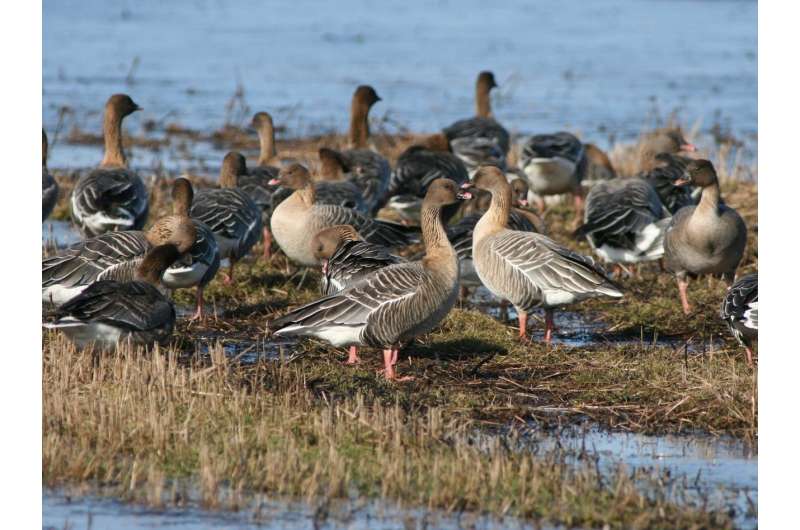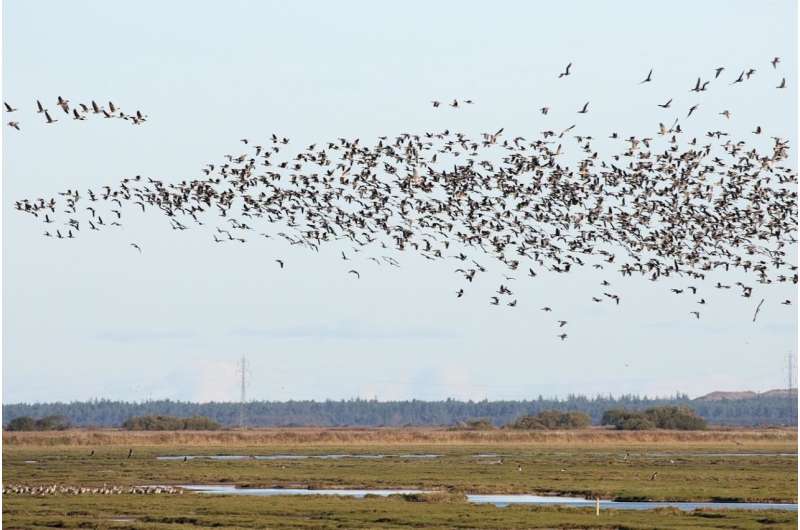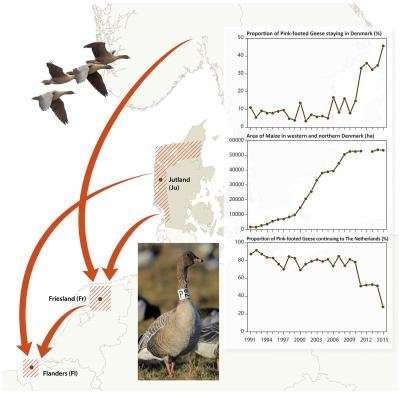Pink-footed geese foraging on arable land in West Jutland, Denmark. Credit: Kevin K. Clausen, AU
Increasing numbers of geese remain in Denmark for the winter. They forage in the growing number of maize fields all over the country. Researchers warn that in the long term, these geese may cause problems for agriculture.
Researchers have learned in school that in autumn, geese migrate southward from the ice-cold North and pass through Denmark on their way to wintering sites in, among other countries, the Netherlands and Belgium. In fact, you may adjust your clock in accordance with their arrival and departure. However, a new study, recently published in the journal Global Change Biology, shows that this is no longer the case.
"We have always believed that geese were very site-faithful birds and returned to the same staging sites year after year. But now, particularly over the past 10 years, we see that more and more geese have changed their migration pattern and stay in Denmark throughout the winter," says researcher Kevin K. Clausen, Department of Bioscience, Aarhus University, who led the recent international investigation.
Geese find new wintering sites
Pink-footed geese are found in very large flocks in West Jutland. All the birds need food. Credit: Jørgen Peter Kjeldsen, ornit.dk
A research team from the Netherlands, Belgium and Denmark has analysed more than 25 years of data covering 370,000 observations of neck-collared pink-footed geese to identify their migration patterns. The data show that about half of the pink-footed geese currently migrating to Denmark stay all winter. About 10 years ago, only 7 percent of the population wintered in Denmark, while the remaining geese continued further south.
"Our results clearly show that migration routes and patterns are dynamic and change when the environment surrounding the geese changes," says Professor Jesper Madsen, Department of Bioscience, Aarhus University, one of the participants in the international study.
"Our data indicate that it is primarily food availability, and not changes in winter temperatures and hunting pressure, that determines where the geese stay in winter," says Kevin K. Clausen.
In the winter, pink-footed geese forage mainly on agricultural grounds. After harvest, the stubble fields are filled with cobs that serve as energy-rich food to the wintering geese. Maize crops are harvested later than most cereal fields, and therefore, there is an increase in winter food availability. The growing number of maize fields in Denmark means that geese do not need to migrate further south under normal winter conditions.
(A) The proportion of pink-footed geese wintering in Denmark. (B) Development in the area of maize in West and North Jutland where the geese winter, and (C) the proportion of pink-footed geese that continue their migration to the Netherlands. All figures are from the period 1990-2015. Credit: Kevin K. Clausen, AU.
"The increasing proportions of geese in Denmark has led to decreasing numbers in the Netherlands and Belgium. This shows that the birds have a high ability of adapting and that they have learnt to exploit the high food availability in the Danish landscape," says Kevin K. Clausen.
The birds' use of the harvested maize fields is generally not a problem for farmers, and it might even alleviate conflicts with grazing on other vulnerable crops in autumn. However, the populations of barnacle geese and pink-footed geese, both increasingly foraging on maize fields, are growing in Denmark and elsewhere in Europe. If enhanced availability of maize leads to even more wintering geese in Denmark, this may cause conflicts with agriculture as the geese may turn to other crops, including grass fields in spring and winter crops.
Growing numbers of geese also present a problem to the air traffic around airports. In Copenhagen Airport, collisions between flying geese and airplanes occur every year. A goose weighing several kilos may cause serious damage when sucked into a jet engine or colliding with a fast flying airplane.
Also in the vulnerable Arctic ecosystems, an increase in the populations of geese may result in severe damage. When the geese arrive in the Arctic to breed, they forage on the sparse tundra vegetation and their droppings fertilize an ecosystem that does not usually receive many nutrients.
Accordingly, conversion of Danish agricultural land to more maize fields will influence many of the problematic issues related to geese.
More information: Kevin K. Clausen et al, Highly dynamic wintering strategies in migratory geese: Coping with environmental change, Global Change Biology (2018). DOI: 10.1111/gcb.14061
Journal information: Global Change Biology
Provided by Aarhus University
























